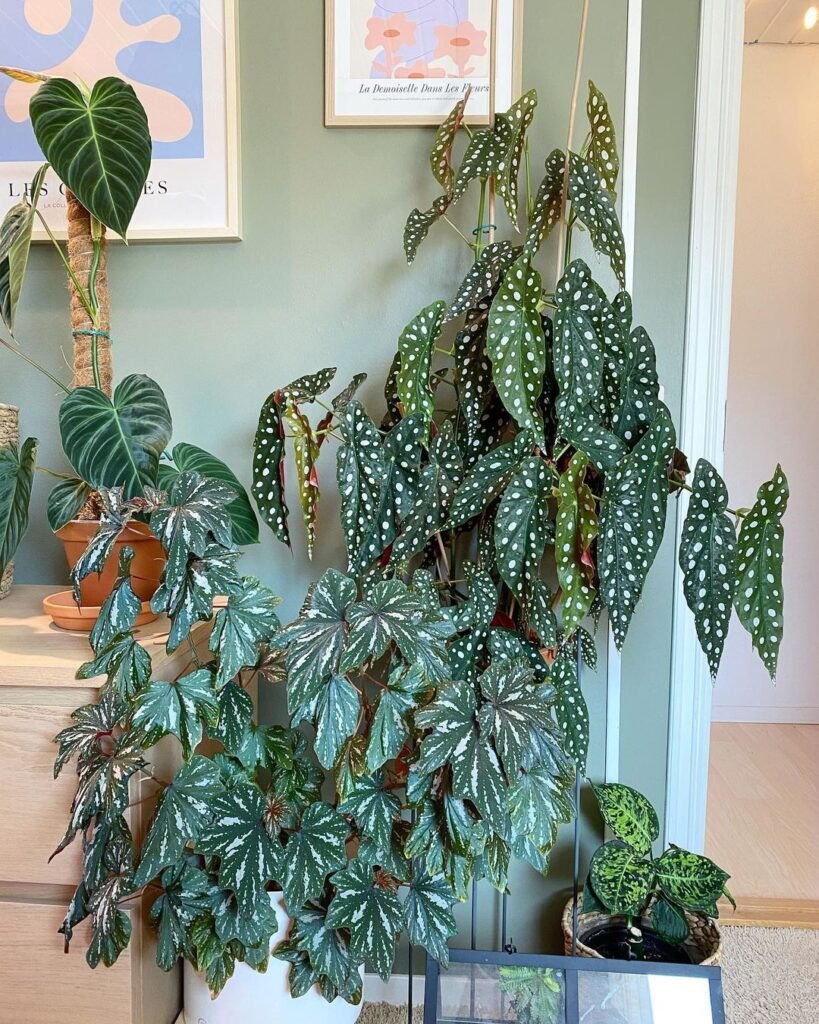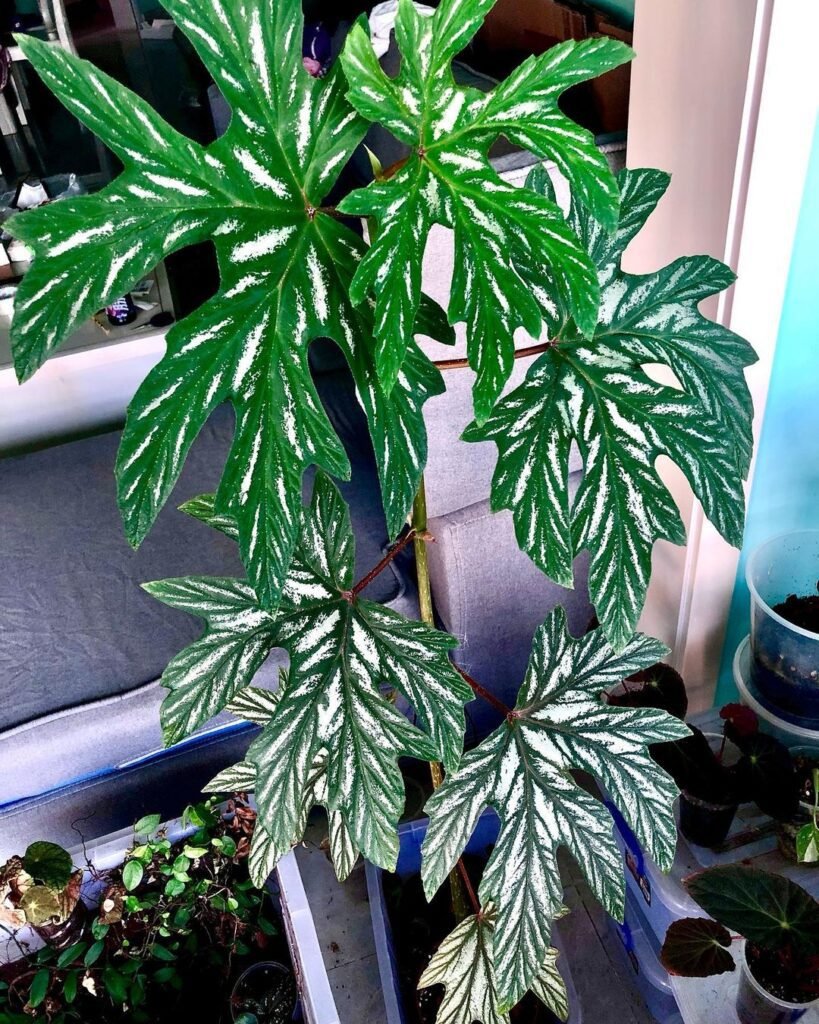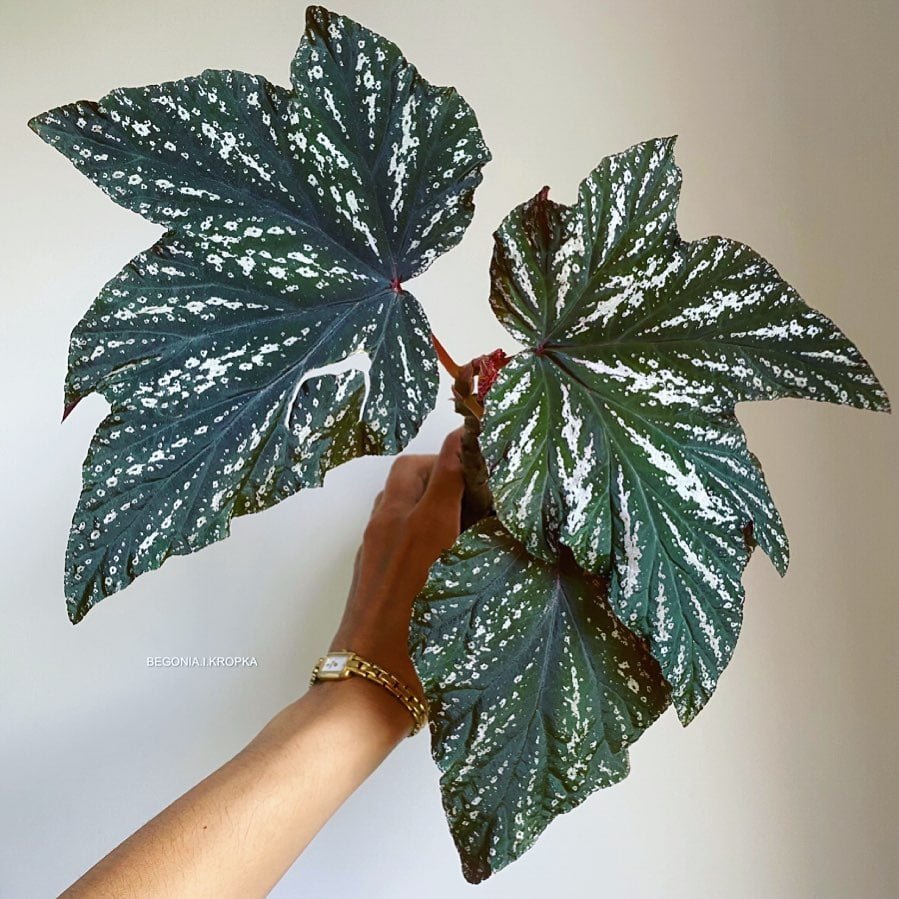Delving into the enchanting world of Begonia Aconitifolia feels like entering a secret garden where each leaf whispers tales of natural beauty.
With a keen interest in cultivating a personal oasis of greenery, exploring various plant varieties has been both a hobby and a personal pursuit. Amidst this foliage-rich journey, Begonia Aconitifolia emerges as a distinctive treasure, showcasing resilience and timeless grace.
Key Takeaways:
- Rooted in Rich Soil: Originating from the mystical landscapes of South America, Begonia Aconitifolia carries a captivating history, deeply intertwined with the vibrant ecosystems of its native region.
- Leafy Elegance: A botanical marvel, this begonia variant stands out with its intricately patterned leaves, resembling delicate lace. Each leaf is a testament to the exquisite artistry found in the natural world.
- Adaptable Charm: Whether enhancing indoor spaces or gracing outdoor gardens, Begonia Aconitifolia possesses the remarkable ability to adapt gracefully, bringing a touch of sophistication to diverse environments.
- Seasonal Symphony: Witness the begonia’s ever-changing beauty as it unfolds its petals throughout the seasons, creating a dynamic and visually stunning display that captivates plant enthusiasts.



Care Guide Overview
| Care Aspect | Overview |
|---|---|
| 💧 Watering | 1. Begonia Aconitifolia thrives in well-draining soil. Water when the top 1-2 inches of soil feels dry to the touch. Avoid overwatering to prevent root rot. |
| ☀️ Lighting | 2. Provide bright, indirect light for optimal growth. Protect from harsh midday sun, which can scorch the leaves. |
| 🌱 Soil and Fertilizing | 3. Use a peat-based soil mix with added perlite for aeration. Fertilize every 4-6 weeks during the growing season with a balanced liquid fertilizer. |
| 💨 Humidity and Temperature | 4. Maintain a humidity level of 50-60%. Keep temperatures between 65-75°F (18-24°C), avoiding sudden fluctuations. |
| ✂️ Pruning and Shaping Tips | 5. Regularly remove dead or yellowing leaves to encourage new growth. Shape the plant by pinching back stems to maintain a bushy appearance. |
| 🌱 Propagation Tips | 6. Easily propagate from stem cuttings in water or soil. Ensure each cutting has at least one node. |
| 🏺 Repotting Tips | 7. Repot every 1-2 years or when the plant outgrows its container. Use fresh soil and ensure proper drainage. |
| 🐞 Pest Control Tips | 8. Keep an eye out for common pests such as aphids and spider mites. Treat with insecticidal soap or neem oil if necessary. |
| 🌱 Reviving a Sick or Wilting Begonia Aconitifolia | 9. Identify the issue – adjust watering, lighting, or soil accordingly. Trim away damaged parts and provide a conducive environment for recovery. |
Appearance of Begonia Aconitifolia



Begonia Aconitifolia stands out with its compact, bushy growth, reaching 12-18 inches in height. The leaves steal the spotlight, featuring an intricate lace-like pattern and serrated edges, creating a whimsical charm. The vibrant green hues, occasionally revealing a hint of red underneath, form a visually stunning palette.
Mature plants develop a dense foliage canopy, making them a captivating addition to both indoor and outdoor settings. This begonia effortlessly combines elegance with botanical fascination.
Not the plant for you? Check out my full list of 78 Types of Begonia!
How to Grow Begonia Aconitifolia
Growing Begonia Aconitifolia is a rewarding journey that requires attention to its specific needs. Here’s a detailed guide to help you nurture this botanical gem from a tiny seedling to a flourishing plant.
💧 Watering
Begonia Aconitifolia thrives in consistently moist soil but is susceptible to root rot if overwatered. Here’s a care tip: Ensure the top 1-2 inches of soil are dry to the touch before watering. Use a watering can with a narrow spout to deliver water directly to the soil, avoiding moisture on the leaves, which can lead to fungal issues.
☀️ Lighting
Provide your begonia with bright, indirect light for optimal growth. Avoid direct sunlight, especially during the harsh midday hours, as it can scorch the delicate leaves. Consider placing it near a north or east-facing window to capture gentle sunlight. If natural light is limited, supplement with artificial fluorescent lights.
🌱 Soil and Fertilizing
Use a well-draining peat-based soil mix with added perlite to ensure proper aeration. Fertilize your Begonia Aconitifolia every 4-6 weeks during the growing season with a balanced liquid fertilizer. Here’s a care tip: Dilute the fertilizer to half the recommended strength to prevent nutrient buildup, which can harm the plant.
💨 Humidity and Temperature
Maintain a relative humidity level of 50-60% for your begonia. If your indoor environment is dry, consider placing a tray of water near the plant or using a humidifier. Keep temperatures between 65-75°F (18-24°C), avoiding sudden fluctuations. Protect the plant from drafts, as it can be sensitive to temperature changes.
✂️ Pruning and Shaping Tips



Pruning is a crucial aspect of maintaining the health and aesthetics of your Begonia Aconitifolia. Follow these specialized tips to ensure your plant stays vibrant and well-shaped.
1. Leaf Maintenance
Regularly inspect your begonia for damaged, yellowing, or diseased leaves. Using sharp, clean scissors or pruning shears, carefully trim these leaves at the base of the stem. This not only improves the plant’s appearance but also prevents the spread of diseases.
2. Pinching Back for Bushiness
To encourage a bushy and compact growth habit, employ the pinching-back method. Using your thumb and forefinger, pinch off the tips of young stems. This stimulates the growth of lateral shoots, resulting in a fuller and more robust begonia. Repeat this process periodically, especially during the growing season.
3. Controlling Height
If your begonia is becoming too leggy or tall, selectively prune the longer stems using pruning shears. Focus on cutting just above a leaf node to promote branching. This technique helps maintain an attractive and well-proportioned appearance.
4. Shaping Techniques
Experiment with shaping your begonia by guiding its growth. For a more structured look, use small stakes or wire supports to gently guide the stems. As the plant grows, it will follow the desired form, creating an artistic and customized display.
🌱 Propagation Tips
Propagating Begonia Aconitifolia allows you to share the beauty of this plant with others or create new plants for different areas of your home or garden. Here are specialized propagation methods to try:
1. Stem Cuttings in Water
- Select healthy stems: Choose stems that are free from diseases and have at least two nodes.
- Prepare the cutting: Trim a 4-6 inch segment just below a node, removing any leaves from the lower part.
- Place in water: Submerge the cutting in a glass of water, ensuring that the node is submerged.
- Root development: After a few weeks, roots should develop. Once they reach a couple of inches in length, transplant the cutting into soil.
2. Leaf Cuttings in Soil
- Choose healthy leaves: Select leaves with no signs of damage or disease.
- Cut and treat: Cut the leaves into sections, ensuring that each section has a vein. Optionally, dust the cut ends with rooting hormone.
- Plant in soil: Insert the cut ends into a well-draining potting mix, burying them slightly.
- Maintain humidity: Cover the cuttings with a plastic dome or a clear plastic bag to create a humid environment for root development.
| Propagation Method | Advantages | Disadvantages |
|---|---|---|
| Stem Cuttings in Water | – Easy and straightforward | – Longer time for roots to develop |
| – Visible root development | – Requires regular water monitoring | |
| – Suitable for beginners | ||
| Leaf Cuttings in Soil | – Higher success rate in root development | – Requires more attention to humidity |
| – Faster root establishment | – Initial steps may be slightly more involved | |
| – Well-suited for propagation trays |
Take propagation beyond the basics with adventurous methods that add an element of excitement to growing new begonias:
- Air Layering Magic: Encourage roots while the stem is attached, providing a seamless transition when the new plant is ready for independence.
- Propagation Parties: Gather friends for a propagation party, where each person can take home their own begonia cutting rooted in water, fostering a sense of community and shared plant joy.
🌿 Unique Companion Plants for Begonia Aconitifolia



Enhance the visual appeal of your garden or indoor space by strategically choosing companion plants that complement the beauty of Begonia Aconitifolia. Consider pairing it with the delicate fronds of ferns, the vibrant blooms of impatiens, or the cascading foliage of creeping Jenny. Create a harmonious botanical ensemble with diverse textures and colors.
| Companion Plant | Features | Placement Tips |
|---|---|---|
| Ferns | Adds a touch of elegance with delicate fronds. | Plant around the base of Begonia for a layered effect. |
| Impatiens | Offers vibrant blooms in various colors. | Intersperse among Begonia for pops of contrasting hues. |
| Creeping Jenny | Cascading foliage provides a trailing effect. | Plant in hanging baskets alongside Begonia for a lush look. |
If you’re thinking of extending your begonia family, I recommend considering either bat wing begonia or begonia angelique. They both would make great additions to your squad!
🌸 Seasonal Care
Understand the seasonal needs of Begonia Aconitifolia to ensure year-round health and vitality. From spring awakening to winter dormancy, each season brings unique challenges and opportunities for your plant. Tailor your care routine to accommodate these changes and witness the begonia’s dynamic transformations.
| Season | Care Focus |
|---|---|
| Spring | Promote new growth with balanced fertilization. |
| Summer | Shield from intense sunlight; monitor humidity. |
| Autumn | Gradually reduce watering as temperatures drop. |
| Winter | Provide moderate light; limit watering. |
🚫 Common Mistakes to Avoid with Begonia Aconitifolia
Learn from the pitfalls of fellow plant enthusiasts and avoid common mistakes that can hinder the growth and well-being of Begonia Aconitifolia. By steering clear of these missteps, you’ll set the stage for a thriving and vibrant begonia.
| Mistake | Consequence | Preventive Measures |
|---|---|---|
| Overwatering | Risk of root rot and fungal diseases. | Allow the soil to dry between watering; use well-draining soil. |
| Insufficient Light | Leggy growth and lack of vibrant foliage. | Provide bright, indirect light; supplement with artificial light if needed. |
| Ignoring Pest Signs | Reduced vigor and potential infestations. | Regularly inspect for pests; treat at the first sign of trouble. |
🌱 Feng Shui Harmony with Begonia Aconitifolia
Discover the ancient art of Feng Shui and how incorporating Begonia Aconitifolia into your living spaces can bring positive energy and balance:
- Bagua Placement: Position your begonia in the Health and Family area (East) to promote growth and vitality, or in the Wealth and Prosperity corner (Southeast) for financial abundance.
- Elemental Balance: The elemental energy of wood associated with begonias complements the Fire element. Introduce red or purple blooms to enhance this fiery energy.
🌐 Essential Tools for Begonia Success
Equip yourself with the essential tools needed to nurture a thriving Begonia Aconitifolia. From specialized fertilizers to unique watering techniques, build a toolkit tailored to your plant’s needs:
- Nutrient Elixirs: Experiment with organic fertilizers like worm castings or seaweed extract to provide a diverse range of nutrients, promoting holistic plant health.
- Rainforest Rituals: Incorporate misting into your routine to create a humid rainforest environment, mimicking the begonia’s natural habitat for optimal growth.
Conclusion
In the lush tapestry of botanical wonders, Begonia Aconitifolia emerges as a true gem, offering both novices and seasoned plant enthusiasts a captivating journey into the world of vibrant greenery. Through this exploration, we’ve uncovered the intricacies of care, the poetry of blossoms, and the artistry of propagation.
Cultivating Begonia Aconitifolia is more than nurturing a plant; it’s a dynamic relationship where each leaf and bloom communicates a story of resilience and natural elegance. From the circadian dance of care routines to the language spoken by delicate blooms, every aspect of this begonia invites us into a deeper connection with the natural world.
As you embark on your begonia adventure, remember that each tip, ritual, and moment of observation contributes to the flourishing narrative of your plant. Let this journey be a testament to the joy found in fostering life, and may your Begonia Aconitifolia grace your surroundings with timeless beauty.
Continue to explore, ask questions, and adapt your care approach, for in the ever-evolving dance between caretaker and plant, the most delightful discoveries often unfold. May your Begonia Aconitifolia thrive, bringing both botanical elegance and a touch of enchantment to your green haven. Happy gardening!
FAQs
Is Begonia Aconitifolia suitable for beginners?
Absolutely! Begonia Aconitifolia is a great choice for beginners. It’s adaptable and forgiving, making it an ideal companion for those just starting their plant journey. Ensure proper care, and your begonia will thrive.
How often should I water my Begonia Aconitifolia?
Watering frequency depends on various factors such as humidity, temperature, and soil type. In general, water when the top 1-2 inches of soil feels dry to the touch. Adjust the frequency based on your specific growing conditions.
Can Begonia Aconitifolia be grown outdoors?
Yes, Begonia Aconitifolia can be grown outdoors, but it’s crucial to provide the right conditions. Choose a shaded or partially shaded area with well-draining soil. Protect the plant from harsh sunlight and ensure it receives adequate water.
What are common pests for Begonia Aconitifolia, and how can I control them?
Common pests include aphids and spider mites. Regularly inspect your begonia for signs of infestation. Treat with insecticidal soap or neem oil if pests are present. Maintaining good hygiene and keeping the plant healthy can also prevent pest problems.
How can I revive a sick or wilting Begonia Aconitifolia?
Identify the cause of distress, whether it’s overwatering, inadequate light, or other factors. Adjust the care routine accordingly. Trim away damaged parts, provide optimal conditions, and monitor for signs of recovery. Patience and consistent care are key to reviving a struggling begonia.
Can Begonia Aconitifolia be propagated from seeds?
While it is possible to propagate Begonia Aconitifolia from seeds, it’s not the most common method. The plant is often propagated through stem cuttings in water or soil, as it yields quicker and more reliable results. Experiment with different methods to find what works best for you.

Writer/Green Thumb/Explorer – Rooted deep in the rich soils of Devon, I’ve cultivated a vast expertise in plant care, helping greenery thrive in homes across the UK. When I’m not crafting detailed plant care guides, I’m journeying through the lush landscapes of the West Country, unearthing nature’s secrets and sharing them with fellow plant enthusiasts. Every leaf has a story, and I’m here to tell it.





